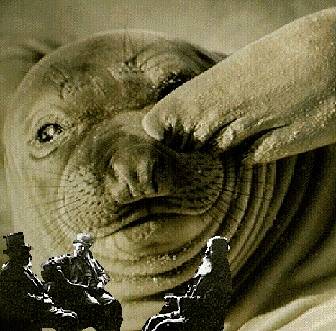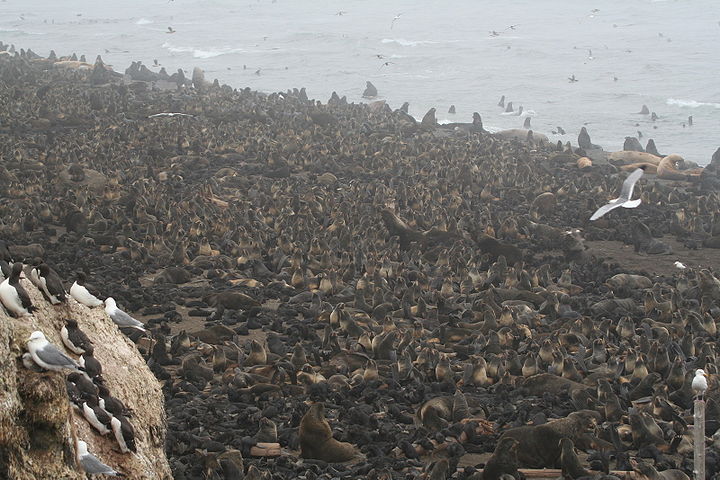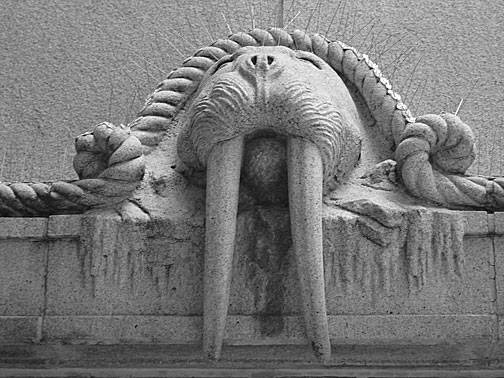ALASKA COMMERCIAL CORPORATION
Historical Essay
by Gray Brechin, Excerpted from his book Imperial San Francisco, published in Upriver, Downriver, Fall 1993
Gustave Niebaum, Lewis Gerstle, Louis Sloss, founders of the Alaska Commercial Company
| The Alaska Commercial Company was founded by Mark Gerstle and Louis Sloss in 1868 and would become one of the world’s largest fur suppliers in the late 19th century. Lucrative, dramatic overharvesting led to near-extinction for fur seals and was eventually outlawed in 1914. After this collapse, the families invested their newfound wealth into railroads, mining operations, and electric companies, which helped speed the development of the Sacramento Valley. |
In the 1985 John Boorman movie, The Emerald Forest, an Amazonian chief describes the men who are mowing down his forest as termites. To the Indians, these fast-moving predators are pale, eat everything in sight, and move on quickly from the deserts they've created. What the white men call development the Indians perceive as consumption of all that supports life: the former have no love for nor identity with place, which is everywhere and always a commodity to be consumed.
Armed with a vastly superior technology, such people would, of course, resent being likened to an insect. How, then, to make them understand what the natives feel at seeing their world turned to desert? The only thing that the termites do not treat as commodity is their own children, so the Indians kidnapped the young son of an American engineer and took him into the forest. Their trade of person for place forces one white man to experience something akin to the pain that the natives do. In the next ten years, the Indians raise the engineer's son at their own neolithic level of technology, thus (in the movie's terms) civilizing him.
"It is a tutelary example that most termites never learn, and so they go on, eating their way through a world they can only understand as having exchange value. Take an article by San Francisco Examiner real estate reporter Bradley Inman, for example. Titled "Californians Bet on Las Vegas," it opens with the case of Mark and Betty L. Gerstle who, despite their love of the urban way of life and the culture that The City offers, including the Opera, the Symphony, and the literary and art scenes, have moved on to the newly Amazonian enclaves of outer Las Vegas. "Sure I miss Trader Vics, but it comes down to economics," says Mark Gerstle, who (according to Inman) now uses his thirty years of experience in public relations to do volunteer boosterism for Las Vegas. With no conscious irony, Inman writes that Mark and Betty, like thousands of other retired Californians, have discovered in Sun City one of the planned-unit communities that are attentive to design and the environment and are packed with the recreational features they have come to expect.
Very far from being attentive to the environment, Sun City's recreational features require a radical transformation of the Las Vegan landscape as well as a voracious consumption of land and water at an ever-greater remove to keep the illusion of the electric oasis alive.
Inman likewise missed a considerable subtext in choosing his typical protagonists, photographed standing by their suburban mailbox, safely removed from the other city which their ancestors built, used and endowed. Mark L. Gerstle is none other than Mark Gerstle III, great-grandson of Lewis Gerstle who, with his brother-in-law Louis Sloss, built San Francisco's Alaska Commercial Company into what was probably the world's greatest fur supplier in the late 19th century. Mark III is related through an extraordinarily tangled genealogy to a clan of rich families in San Francisco, including the Fleishackers, Lilienthals, Haases, Koshlands, and, of course, the Slosses. Together, they represent a pool of capital which served to suddenly reshape the American West and the Arctic, transforming vast realms into a treasure trove of commodities bought and sold on the city's markets. With the surplus profits derived from that long-distance mutation, they lived well and could afford to be generous. Their philanthropy paid for a good deal of the culture that The City offers, as well as its charities, so that when they bail out, a shoe has dropped that Inman didn't hear.
San Francisco's founders saw the Pacific Basin as mare nostrum, a virgin bonanza literally tributary to the city they claimed as their own. Taking their cue from the earlier and spectacularly successful operations of John C. Fremont in California, filibusterers sailed out the Golden Gate in the 1850s and '60s to liberate chunks of Mexico, Nicaragua, Borneo and Hawaii, along with their resources and labor, for the United States and themselves. Among the greatest plums was Alaska, acquired from Russia in 1867 by Secretary of State William H. Seward. Bank of California chief William Ralston and his partners were anxious to exploit the nearly untapped seal herds of the Pribilof Islands in the South Bering Sea. One of those partners was Louis Sloss, while another was General John F. Miller, collector of the Port of San Francisco, who maintained useful ties to President Ulysses Grant, under whom he had served in the Union Army.
Northern fur seal rookery on Tuleny Island off the Siberian coast, much as the Pribilof Islands would have appeared when the Alaska Commerical Corporation began its decades-long "harvest."
Image: Wldland, wikimedia commons
The Alaska Commercial Company was formed on January 1, 1868, with Louis Sloss as president. The following year, Sloss appointed Miller president of the company after the latter had acquired exclusive rights to harvest the Pribilof seal herds. Louis Sloss and Mark Gerstle, in fact ran the business -- particularly after Miller went to the U.S. Senate in 1881 to represent California and the Company in the Capitol. The ACC became the fount of the Sloss-Gerstle dynastic fortunes, and the de facto government of Alaska.
In one of many official family histories, the Pribilofs are described as two little specks in the Bering Sea which were to be carefully and wisely harvested into a commercial and social empire. The islands were then home to 80 percent of the world's fur seals. They were harvested strictly according to government regulations, apparently written by Miller. Aleut sealers took an average of 100,000 skins per year during the twenty years of the ACC lease.
In termite terms, one can regard seals as a renewable resource, but the ACC's take greatly exceeded the seals breeding capacity. By 1882, the Pribilof herds began to show a drastic decline in numbers, and the ACC began to kill younger seals and to expand operations into areas that had previously been ignored. Nonetheless, company records show that the annual take did not decrease; by 1889, when its lease ran out, the company had harvested a reported 1,850,000 seal skins, for which it had paid the U.S. government nearly $9.5 million. Its stockholders had harvested a reported $18 million in profits over the same period.
This granite walrus head adorns the building on California Street (between Sansome and Battery) that replaced the old Alaska Commercial Corporation building, torn down in 1975, which itself once featured dozens of animal sculptures representing starkly the source of the company's wealth.
Photo: Chris Carlsson
Treating the Arctic as a classic mining region, the Alaska Commercial Company extended its transportation and supply routes until it had 91 stations in Alaska, the Yukon and Siberia. Through these posts, trappers kept the company well supplied, not only with seal furs, but with red, white, blue and silver fox, otters, marten, mink, wolf, wolverine, bears (including polar), muskrat, ermine, lynx, beaver, sable, ivory, swanskin and whalebone. Furs and feathers were shipped to London for auction, then reshipped to the United States for processing and resale.
By the laws of supply and demand, the increased rarity of Arctic animals spurred on their slaughter. Year by year, the valuable and once-plentiful fur-bearing animals of North America are becoming more rare -- in fact, extinct, and thus more valuable and interesting, reported one observer in 1905. Another likened the skins to valuable heirlooms: Because of its superior warmth, beauty, softness, fineness, etc., seal fur must continue to be fashionable until no more is to be had. As it grows rarer, it must of course grow more valuable. Those who possess handsome pieces of it may show them at no very distant day much as they would now show a blue diamond.
The Alaska Commercial Company building, built in 1908, had not only walruses but also icicles and sea serpents, representing the environment of the far north from which they derived the corporate wealth.
Photo: San Francisco Architectural Heritage
The official family histories of the Sloss and Gerstle clans and all their collateral branches depict the founders as paragons of vision and probity in business, devoted as husbands, fathers and community leaders in their personal lives. They built family compounds in city and country (Slosses and Gerstles maintained an expansive Victorian estate overlooking San Rafael) where wives and children were given every advantage that Alaska could provide, far from the messy killing fields of the Pribilofs. None of the histories examines the Company's ecological impact as it consumed the living ore of the Arctic; in fact, Sloss and Gerstle never saw Alaska, but directed operations at a healthy remove through their partner, Captain Gustave Niebaum, and employees.
When the Company's lease expired in 1890, the federal government gave it to a company headed by San Francisco furrier Isaac Liebes. It was financed by William Ralston's old partner in the Bank of California, Darius Ogden Mills. The Pribilof mine, however, was nearing exhaustion. Alarmed by thinning herds, Treasury agent Charles Goff warned that "there be no killing of fur seals... for an indefinite number of years." Fur yield continued to drop until the United States outlawed sealing in 1914 to prevent complete extinction of the animals.
When the Pribilof lease expired, the Slosses and Gerstles reinvested their capital in a variety of enterprises, including salmon canneries, a tannery, mines, transportation, utilities and especially land reclamation and speculation in California. They were particularly interested in traction, investing in street railroads in Chicago, New York and Philadelphia, and, with Claus Spreckels, financed the building of a railroad meant to rival the Southern Pacific in the San Joaquin Valley. Yet unlike Spreckels and other San Francisco financiers, they and their sons seldom dominated companies but owned stock or served on boards of directors, often representing family holding companies. Their names are therefore not well known to the general public today, and their interests are hard to trace without elaborate corporate cross-referencing and intimate genealogical familiarity.
It is, however, clear that the families were heavily involved in the development of the Sacramento Valley. In 1905, the Northern Electric Railroad Company was incorporated to build an interurban system from Chico to Oakland in competition with the Southern Pacific. Among the railroads partners were mining engineers earlier involved in hydraulic mining operations on the Yuba River; after these operations were outlawed in 1884, the engineers turned their expertise to long-range electrical transmission which would in turn serve to drain marshes, milk cows, build cities, and power enormous gold dredges (which they also owned on the Sacramento's tributaries). Engineers and entrepreneurs were virtually all tied with the syndicate that assembled PG&E (Pacific Gas and Electric) or its rival, Great Western Power, whose corporate goal it was to develop the resources of California and attract ever more immigrants to fill up the state's empty spaces.
The personal and familial links represented by the nexus of San Francisco capital can be diagrammed spatially: a number of family-owned office buildings or businesses allied with the Alaska Commercial Company were within no more than three blocks of its headquarters at Sansome and California Streets, or they occupied offices within the ACC Building itself (e.g. the Natomas Reclamation Company, which left an expansive legacy of sterile dredge tills east of Sacramento). Cherny and Issel have noted how nicely genetic, fiduciary and spatial intimacy coincided in San Francisco:
The sense of unity displayed by the city's business community evolved in a propitious setting. San Francisco enjoyed economic autonomy matched only by New York's... Nearly all of the city's businesses were owned and operated by San Franciscans, whose interests ranged from Alaskan fisheries to Hawaiian sugar plantations, from Mexican mining operations to hydroelectric power in the Sierra, from logging in Washington to San Joaquin wheat fields. They operated on an imperial scale, but most of their corporate boardrooms were within a few blocks of one another. They ate lunch in the same Financial District restaurants or in exclusive club rooms, saw each other regularly at the meetings of corporate and civic boards, worshipped in a few prestigious churches and synagogues, and watched fondly as their children married the children of friends [or cousins].
Above all, the goal of these men was to increase the population of California and thus, the value of the thousands of acres of land which they owned. William Thomas, president of the California Water and Forest Association, spoke for them all when he told the Merchants Association in 1900 that "The bare statement of the objects of the Association should arouse the patriotism and public spirit of every good citizen of the state and particularly of the merchants of San Francisco who have waked to the self-evident fact that their future depends upon the development of the interior. With a territory larger than that of New England and the Middle States, capable of supporting a population denser than that of any country in the world, California has a population about as large as the city of Chicago and not one-tenth of its public spirit." [Emphasis added.] It was to fill this vacuum that PG&E, Great Northern, the Northern Electric Railroad, and the various land reclamation companies such as Natomas were formed at the turn of the century, partly with profits derived from the skins and tusks of northern mammals. Capital made from the consumption of Arctic resources turned then to the consumption [development] of California land in the commodity form of real estate.
The third and fourth generations of Sloss-Gerstles did not display the same enterprising gusto as had the founders and the family's fortunes declined relative to what they had been. In 1917, the Northern Electric declared bankruptcy, putting a severe strain on pooled capital. Dr. Mark Gerstle, Jr., Mark III's father, died without a cent after going through six marriages and numerous affairs. Despite the advantages afforded by family connections, Betty Gerstle may not have been exaggerating when she told the Examiner's reporter that Rossmoor's houses were twice what even Gerstles could afford.
No one can re-create San Francisco, but there are some alternatives that are much more affordable, concluded Betty's husband Mark. Las Vegas, the current alternative, doubled its population in ten years to nearly 800,000, and is now the fourth fastest-growing city outside of Florida, yet without that state's copious rainfall. Like San Francisco, the growth of Las Vegas and the appreciation of its real estate is sustained in rivalry with and at the expense of a wider tributary region, which must supply an ever-growing flood of water and energy to assure the new residents of Sun City, Green Valley, Crystal Creek, Bay Breeze, and other putatively planned communities that they are not, in fact, living in a desert. Like Rome revived, Las Vegas sends its aqueducts ever farther afield to keep its imperial momentum going. The Las Vegas Valley Water District now has plans to tap into the Pleistocene groundwater that nourishes the scanty springs and rivers of Nevada. Just as long as those aquifers and the Colorado hold out, Mark Gerstle's promotional efforts will bear fruit in continued growth. Twenty years is probably optimistic.
Seals, foxes, bears and birds once enriched the Gerstle family, the more so as those species vanished. So too did the Sacramento Valley as it filled with people for whom the Slosses and Gerstles once provided the power and transportation, so that finally, California was priced out of the reach of even Gerstles. Arizona and Nevada, says Inman, are now attracting the upscale second-home buyers -- many of whom would have picked Monterey, Palm Springs or a beach location in Orange County ten years ago.
Though Mark and Betty speak only in economic terms of why they have traded California for Nevada, there are doubtless other reasons. Fascinated by the nervous malaise which seems to permeate Las Vegas suburbs, Harpers' reporter David Gusterson asked the residents of a new walled town "Why do you live here?" but the people of Green Valley, with disconcerting uniformity, were almost never entirely forthcoming. Gusterson found that they were fleeing from the problems of urban growth, as much as they were to the low prices, 18-hole golf courses, and aquacizing classes that Inman emphasizes. This sere landscape of intolerable heat and razor-ridged mountains has, perforce, become the last best place now that California is gone. The walls, gates and sentries symbolize the hoped-for security, the lawns, lagoons and fountains a temporary stand against the cities crises as much as natures limitations. No Shoshone chief stalking the perimeter will borrow a Gerstle grandchild to teach the price of a limitless appetite. As if propelled by the same instinct that drives termites, Mark III does what he knows best to do: promotional consumption of the place which he occupies for the moment.




